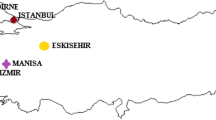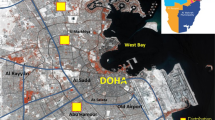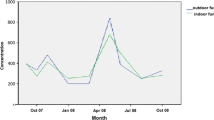Abstract
This paper presents information about airborne mesophilic bacteria in the indoor and outdoor air of child day-care centers (CDCCs) in the city of Edirne, Turkey. Air samples were collected using the Petri plate gravitational settling method from the indoor and outdoor air of CDCCs. Counts of airborne bacteria were measured as colony forming units (CFU) collected by gravity onto Brain Heart Infusion Agar plates (with 5% sheep blood). Samples were taken monthly over a period of 12 months between January and December 2004. A total of 3,120 bacteria colonies were counted on 192 Petri plates. Four groups of culturable bacteria were identified: Gram-positive cocci, Gram-positive bacilli, endospore-forming Gram-positive bacilli, and Gram-negative bacteria. Airborne Gram-positive bacteria were the most abundant at more than 95% of the measured population. While Gram-positive cocci were more common in indoor environments, Gram-positive bacilli were more dominant in outdoor air. Bacteria commonly isolated from CDCCs were identified at a genus level. Staphylococcus (39.16%), Bacillus (18.46%), Corynebacterium (16.25%), and Micrococcus (7.21%) were dominant among the genera identified in the present study. The dominant genera identified in the day-care centers were Staphylococcus, Micrococcus, and Corynebacterium for indoor air and Bacillus, Corynebacterium, and Staphylococcus for outdoor air. Staphylococcus, Streptococcus, Bacillus, and Corynebacterium genera were found in samples from every month. Bacterial colony counts were compared by sampling location (indoors and outdoors), seasons, and meteorological factors. We found negative correlations between the monthly total outdoor bacterial counts and the sampling day’s average relative humidity and average rainfall, and the monthly average rainfall. Fluctuations in bacterial counts in different seasons were observed.
Similar content being viewed by others
References
Arbes, S. J., Sever, M., Mehta, J., Collette, N., Thomas, B., & Zeldin, D. C. (2005). Exposure to indoor allergens in day-care facilities: Results from 2 North Carolina counties. Journal of Allergy and Clinical Immunology, 116, 133–139. doi:10.1016/j.jaci.2005.04.022.
Awad, A. H. A. (2007). Airborne dust, bacteria, actinomycetes and fungi at a flourmill. Aerobiologia, 23, 59–69. doi:10.1007/s10453-007-9049-z.
Awad, A. H. A., Khoder, M. I., & Emad, A. A. (2007). Fertile fungal spores collected on different faced surfaces in the atmosphere of Giza, Egypt. Aerobiologia, 23, 47–57. doi:10.1007/s10453-007-9049-z.
Aydogdu, H., & Asan, A. (2008). Airborne fungi in child day care centers in Edirne City, Turkey. Environmental Monitoring and Assessment, 147, 423–444. doi:10.1007/s10661-007-0130-4.
Aydogdu, H., Asan, A., Otkun, M. T., & Ture, M. (2005). Monitoring of fungi and bacteria in the indoor air of primary schools in Edirne City, Turkey. Indoor and Built Environment, 14, 411–425. doi:10.1177/1420326X05057539.
Baron, E. J., Peterson, L. R., & Finegold, S. M. (1994). Bailey and Scott’s diagnostic microbiology (958 pp., 9th edn.). St Louis, USA: Mosby-Year Book, Inc.
Bartlett, K. H., Kennedy, S. M., Brauer, M., Netten, C. V., & Dill, B. (2004). Evaluation and determinants of airborne bacterial concentrations in school classrooms. Journal of Occupational and Environmental Hygiene, 1, 639–647. doi:10.1080/15459620490497744.
Bovallius, A., Bucht, B., Roffey, R., & Anas, P. (1978). Three-year investigation of the natural airborne bacterial flora at four localities in Sweden. Applied and Environmental Microbiology, 35, 847–852.
Di Giorgio, C., Krempff, A., Guiraud, H., Binder, P., Tiret, C., & Dumenil, G. (1995). Atmospheric pollution by airborne microorganisms in the city of Marseilles. Atmospheric Environment, 30, 155–160. doi:10.1016/1352-2310(95)00143-M.
Dunder, T., Tapiainen, T., Pokka, T., & Uhari, M. (2007). Infections in child day care centers and later development of asthma, allergic rhinitis, and atopic dermatitis. Archives of Pediatrics & Adolescent Medicine, 161, 972–977. doi:10.1001/archpedi.161.10.972.
Fabian, M. P., Miller, S. L., Reponen, T., & Her nandez, M. T. (2005). Ambient bioaerosol indices for indoor air quality assessments of flood reclamation. Aerosol Science, 36, 763–783. doi:10.1016/j.jaerosci.2004.11.018.
Fang, Z., Ouyang, Z. Y., Hu, L. F., Wang, X. K., & Lin, X. O. (2005). Community structure and ecological distribution of airborne microbes in summer in Beijing. Acta Ecologica Sinica, 25, 83–88.
Fang, Z., Ouyang, Z. Y., Zheng, H., Wang, X., & Hu, L. (2007). Culturable airborne bacteria in outdoor environments in Beijing, China. Microbial Ecology, 54, 487–496. doi:10.1007/s00248-007-9216-3.
Fischer, G., Albrecht, A., Jäckel, U. & Kämpfer, P. (2008). Analysis of airborne microorganisms, MVOC and odour in the surrounding of composting facilities and implications for future investigations. International Journal of Hygiene and Environmental Health, 211, 132–142. doi:10.1016/j.ijheh.2007.05.003.
Godish, D. R., & Godish, T. J. (2007). Relationship between sampling duration and concentration of culturable airborne mould and bacteria on selected culture media. Journal of Applied Microbiology, 102, 1479–1484. doi:10.1111/j.1365-2672.2006.03200.x.
Holt, J. G., Krieg, N. R., Sneath, P. H. A., Staley, J. T., & Williams, S. T. (1994). Bergey’ s manual of determinative bacteriology (9th edn.). USA: Williams & Wilkins.
Howard, B. J., Klaas, J. I. I., Rubin, S. J., Weissfeld, A. S., & Tilton, R. C. (1987). Clinical and pathogenic microbiology (968 pp.). St Louis: The, C, V. Mosby Company.
Jaffal, A. A., Banat, I. M., El Mogheth, A. A., Nsanze, H., Bener, A., & Ameen, A. S. (1997). Residential indoor airborne microbial populations in the United Arab Emirates. Environment International, 23, 529–533. doi:10.1016/S0160-4120(97)00055-X.
Kahan, E., Gross, S., & Cohen, H. A. (2005). Exclusion of ill children from child-care centers in Israel. Patient Education and Counseling, 56, 93–97. doi:10.1016/j.pec.2003.12.012.
Kalogerakis, N., Paschali, D., Lekaditis, V., Pantidou, A., Eleftheriadis, K., & Lazaridis, M. (2005). Indoor air quality-bioaerosol measurements in domestic and office premises. Aerosol Science, 36, 751–761. doi:10.1016/j.jaerosci.2005.02.004.
Kim, K. Y., & Kim, C. N. (2007). Airborne microbiological characteristics in public buildings of Korea. Building and Environment, 42, 2188–2196. doi:10.1016/j.buildenv.2006.04.013.
Koneman, E. W., Allen, S. D., Janda, W. M., Schreckenberger, P. C., & Winn, W. C. (1997). Color atlas and textbook of diagnostic microbiology (1395 pp., 5th edn.) Philadelphia, New York: Lippincott.
Koskinen, O. M., Husmana, T. M., Hyvarinen, A. M., Reponen, T. A., & Nevalainen, A. I. (1997). Two moldy day-care centers: A follow-up study of respiratory symptoms and infections. lndoor Air, 7, 262–268.
Law, A. K. Y., Chau, C. K., & Chan, G. Y. S. (2001). Characteristics of bioaerosol profile in office buildings in Hong Kong. Building and Environment, 36, 527–541. doi:10.1016/S0360-1323(00)00020-2.
Lee, W. K., & Young, B. W. Y. (2006). Infectious diseases in children admitted from a residential child care centre. Hong Kong Medical Journal, 12, 119–124.
Mahdy, H. M., & El-Sehrawi, M. H. (1997). Airborne bacteria in the atmosphere of El-Taif region Saudi Arabia. Water, Air, and Soil Pollution, 98, 317–324.
Masuda, K., Masuda, R., Nishi, J. I., Tokuda, K., Yoshinaga, M., & Miyata, K. (2002). Incidences of nasopharyngeal colonization of respiratory bacterial pathogens in Japanese children attending day-care centers. Pediatrics International, 44, 376–380. doi:10.1046/j.1442-200X.2002.01587.x.
Mui, K. W., Wong, L. T., & Hui, P. S. (2008). Risks of unsatisfactory airborne bacteria level in air-conditioned offices of subtropical climates. Building and Environment, 43, 475–479. doi:10.1016/j.buildenv.2007.01.012.
Murray, P. R., Baron, E. J., Jorgensen, J. H., Pfaller, M. A., & Yolken, R. H. (2003). Manual of clinical microbiology (8th edn.). Washington, D.C.: ASM Pres.
Nafstad, P., Jaakkola, J. J. K., Skrondal, A., & Magnus, P. (2004). Day care center characteristics and children’s respiratory health. Indoor Air, 15, 69–75. doi:10.1111/j.1600-0668.2004.00310.x.
Nevalainen, A., & Seuri, M. (2005). Of microbes and men. Indoor Air, 15, 58–64. doi:10.1111/j.1600-0668.2005.00344.x.
Nilsson, A., Kihlstr, E., Lagesson, V., Wess, B., Szponar, B., Larsson, L., et al. (2004). Microorganisms and volatile organic compounds in airborne dust from damp residences. Indoor Air, 14, 74–82. doi:10.1046/j.1600-0668.2003.00178.x.
Pastuszka, J. S., Paw, U. K. T., Lis, D. O., Wlazlo, A., & Ulfig, K. (2000). Bacterial and fungal aerosol in indoor environment in Upper Silesia, Poland. Atmospheric Environment, 34, 3833–3842. doi:10.1016/S1352-2310(99)00527-0.
Pönkä, A., Poussa, T., & Laosmaa, M. (2004). The effect of enhanced hygiene practices on absences due to infectious diseases among children in day care centers in Helsinki. Infection, 32, 2–7. doi:10.1007/s15010-004-3036-x.
Prospero, J. M., Blades, E., Mathison, G., & Naidu, R. (2005). Interhemispheric transport of viable fungi and bacteria from Africa to the Caribbean with soil dust. Aerobiologia, 21, 1–19. doi:10.1007/s10453-004-5872-7.
Salonen, H., Lappalainen, S., Lindroos, O., Harju, V., & Reijula, K. (2007). Fungi and bacteria in mould-damaged and non-damaged Office environments in a subarctic climate. Atmospheric Environment, 41, 6797–6807. doi:10.1016/j.atmosenv.2007.04.043.
Sarica, S., Asan, A., Otkun, M. T., & Ture, M. (2002). Monitoring indoor airborne fungi and bacteria in the different parts of Trakya University Hospital (Edirne-Turkey). Indoor and Built Environment, 11, 285–292. doi:10.1177/1420326X0201100505.
Seino, K., Takano, T., Nakamura, K., & Watanabe, M. (2005). An evidential example of airborne bacteria in a crowded, underground public concourse in Tokyo. Atmospheric Environment, 39, 337–341. doi:10.1016/j.atmosenv.2004.09.030.
Shaffer, B. T., & Lighthart, B. (1997). Survey of airborne bacteria at four diverse locations in Oregon: Urban, rural, forest, and coastal. Microbial Ecology, 34, 167–177. doi:10.1007/s002489900046.
Shahamat, M., Levin, M., Rahman, I., Grim, C., Heidelberg, J., Stelma, G., et al. (1997). Evaluation of media for recovery of aerosolized bacteria. Aerobiologia, 13, 219–226. doi:10.1007/BF02694489.
Thacker, S. B., Addiss, D. G., Goodman, R. A., Holloway, B. R., & Spencer, H. C. (1992). Infectious-diseases and injuries in child day-care—opportunities for healthier children. Jama-Journal of the American Medical Association, 268, 1720–1726. doi:10.1001/jama.268.13.1720.
Tong, Y., & Lighthart, B. (2000). The annual bacterial particle concentration and size distribution in the ambient atmosphere in a rural area of the Willamette Valley, Oregon. Aerosol Science and Technology, 32, 393–403. doi:10.1080/027868200303533.
Yalcin, S. S., Tugrul, B., Cetinkaya, S., Cakir, B., & Yilmaz, A. (2004). Effect of total attending period on infection episode rate in a child-care center. Pediatrics International, 46, 555–560. doi:10.1111/j.1442-200x.2004.01950.x.
Zhu, H., Phelan, P. E., Duan, T., Raupp, G. B., Fernando, H. J. S., & Che, F. (2003). Experimental study of indoor and outdoor airborne bacterial concentrations in Tempe, Arizona, USA. Aerobiologia, 19, 201–211. doi:10.1023/B:AERO.0000006571.23160.8a.
Author information
Authors and Affiliations
Corresponding author
Rights and permissions
About this article
Cite this article
Aydogdu, H., Asan, A. & Tatman Otkun, M. Indoor and outdoor airborne bacteria in child day-care centers in Edirne City (Turkey), seasonal distribution and influence of meteorological factors. Environ Monit Assess 164, 53–66 (2010). https://doi.org/10.1007/s10661-009-0874-0
Received:
Accepted:
Published:
Issue Date:
DOI: https://doi.org/10.1007/s10661-009-0874-0




